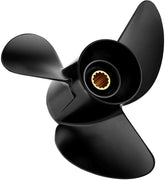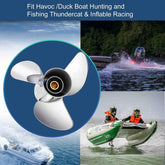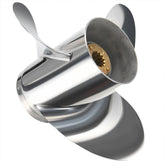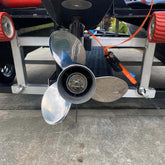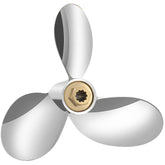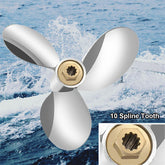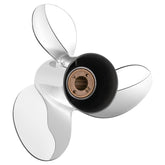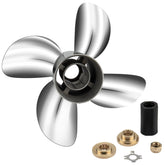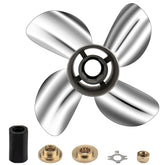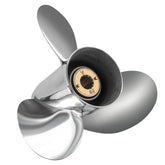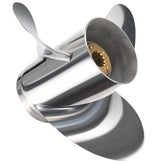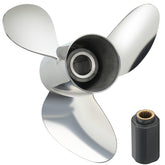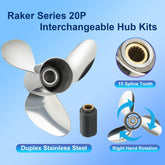Yamaha vs Mercury Propellers: A Detailed Comparison for Boat Owners
If you own a boat, the propeller is the single component that most directly affects acceleration, top speed, fuel consumption, and driveline longevity. Choosing between a Yamaha-style propeller and a Mercury-style propeller isn’t about brand loyalty—it’s about mechanical fit, hydrodynamic performance, and the duty you expect the boat to perform. Below is a practical, engineer-led comparison that helps you decide which path to take: buy an OEM replacement, adapt a competitor blade, or commission a direct-fit prop from a manufacturer like VIF.
What matters first (and always)
Before comparing brands, gather these three decisive data points. They answer most fit-and-performance questions:
-
Prop stamp: diameter × pitch (e.g.,
13 x 19) found on the hub or blade. -
Hub / spline detail: clear photos of the hub interior and the lower-unit input shaft (or part numbers).
-
Engine ID & baseline WOT RPM: engine make/model/year/serial and a recorded wide-open-throttle RPM with the current prop fitted under typical load.
Without those, you’re guessing. With them, you can test and validate any change scientifically.
Mechanical compatibility: the real brand difference
From a fit-and-install standpoint, the decisive factor is hub & spline compatibility, not the embossed logo on the blade.
-
Yamaha and Mercury have different lower-unit designs and may use different spline counts and hub geometries. That means a Yamaha-marked prop may not mount directly to a Mercury lower unit unless the spline and hub match.
-
Options when mixing brands:
-
Direct fit (rare, but ideal): identical spline/profile and clearance — install and test.
-
OEM hub swap: replace the hub to match the lower unit while retaining the prop body — only when prop design supports replaceable hubs.
-
Custom prop manufactured to your spline: build the blade with the correct spline profile for the target lower unit — the most reliable long-term fix.
-
-
Avoid generic adapters for frequent or heavy-duty use. Adapters introduce axial and radial offsets that change torque transfer and can produce premature wear or vibration.
Performance & design differences (what you’ll notice on the water)
Brand labels mean little hydrodynamically; what matters is blade geometry, material, diameter/pitch, and blade count.
-
Blade geometry and tuning
-
Yamaha and Mercury OEM blades are each designed around their engines’ torque curves and cavitation behavior. One brand’s blade may produce better hole-shot on one hull, while the other gives a slightly higher top speed. That’s because each blade optimizes for different tradeoffs in camber, rake, and cup.
-
-
Material
-
Aluminum: lighter, lower cost, repairable; standard for many recreational setups.
-
Stainless steel: stronger, allows thinner sections and better high-RPM efficiency—preferred for high-horsepower engines or performance applications.
-
-
Blade count
-
3-blade: common OEM compromise between acceleration and top speed.
-
4-blade: stronger low-end thrust (better for towing or heavy loads) and improved handling in rough seas.
-
5-blade and specialty designs: used for very specific low-speed thrust or extreme-stability needs.
-
How to decide which to use: a quick decision workflow
-
If you want drop-in simplicity and your engine calls for the same spline/hub as the replacement, choose the OEM or equivalent blade that matches stamped diameter×pitch and material. Then verify WOT RPM.
-
If you like a competitor blade’s hydrodynamic shape but you run a different lower unit, prefer a hub swap or a custom prop made to your lower-unit spline instead of using an adapter.
-
If you operate heavily or under variable loads (frequent towing, lots of full-load runs), invest in a custom-fit stainless prop that matches your spline and is tuned to your boat’s loaded WOT RPM band.
Use RPM to validate performance — not guesswork
The simplest objective test after any prop swap is WOT RPM:
-
Measure baseline WOT with the current prop under a typical load.
-
Compare to the engine manufacturer’s recommended WOT band for your model.
-
If WOT is above the band → prop is too small (increase pitch/diameter).
-
If WOT is below the band → prop is too large (reduce pitch/diameter).
-
-
Make adjustments in small steps (±1–2 inches of pitch) and retest under the same load and trim.
This iterative, measurement-driven process is how you find the balance between hole-shot, cruising efficiency, and top speed without damaging the engine.
Common field problems and practical diagnostics
-
Vibration after swap: often caused by worn hub rubber, spline wear, slight shaft bend, or a hairline blade twist. Check hub condition and shaft runout before blaming blade geometry.
-
Reduced top speed with higher fuel burn: usually a pitch mismatch or blade damage. Verify pitch and inspect blades for dings.
-
Slippage under load: indicates worn or incorrect hub; replace the hub or fit a true direct-fit prop.
Why a custom fit often wins (long-term view)
For ongoing reliability and predictable performance—especially if you run different brands of lower units—a prop manufactured to the exact spline and pitch for your engine and duty cycle is the best investment. That eliminates adapters, minimizes offsets, and reduces the risk of vibration or accelerated wear. A manufacturer with in-house R&D and production (like VIF) can deliver aluminum or stainless propellers, matched hardware kits, and water-pump repair kits to make replacement and installation straightforward.
Practical ordering checklist (what to send to get a precise match)
When you contact a prop manufacturer or supplier, include:
-
Engine brand / model / year / serial
-
Clear photos: prop stamp, prop hub interior, lower unit input shaft
-
Current WOT RPM and typical load (people + gear)
-
Desired outcome (better acceleration, higher top speed, towing performance)
-
Delivery country and contact info
Learn more and place an order
If you want to understand how props are made, read:
How Boat Propellers Are Manufactured
When you’re ready to order a replacement propeller online, visit:
Boat Propeller Online Store
Final word — treat the prop as an engineering problem, not a fashion choice
Choosing a prop isn’t about which logo looks best. It’s about matching mechanical fit (hub/spline), tuning pitch and diameter using measured RPM, and selecting the right material and blade count for your mission. Follow the measurement-test-iterate cycle above, and you’ll get a prop that behaves predictably and lasts. If you'd like, send your engine and prop photos plus the current WOT RPM to VIF—engineers will return an actionable, tested replacement plan (hardware included).


